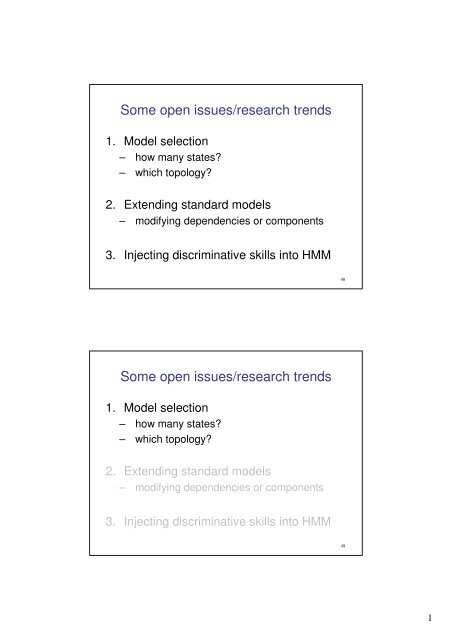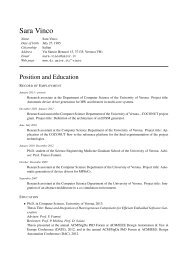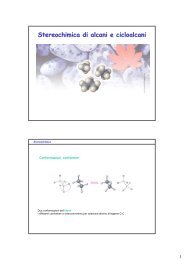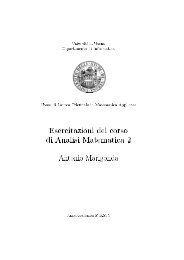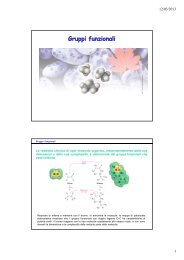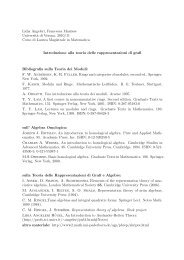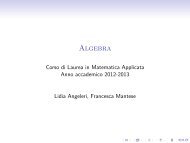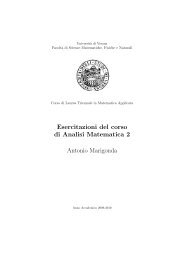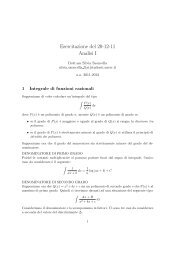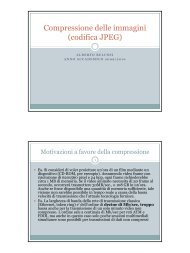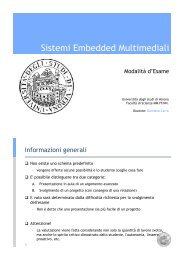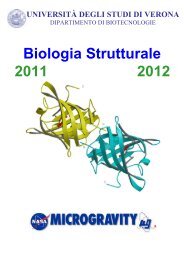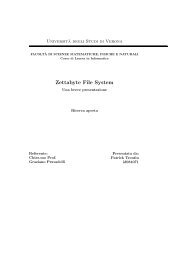7. Hidden Markov Models (Parte 2) (pdf, it, 413 KB, 4/28/10)
7. Hidden Markov Models (Parte 2) (pdf, it, 413 KB, 4/28/10)
7. Hidden Markov Models (Parte 2) (pdf, it, 413 KB, 4/28/10)
You also want an ePaper? Increase the reach of your titles
YUMPU automatically turns print PDFs into web optimized ePapers that Google loves.
Some open issues/research trends<br />
1. Model selection<br />
– how many states?<br />
– which topology?<br />
2. Extending standard models<br />
– modifying dependencies or components<br />
3. Injecting discriminative skills into HMM<br />
Some open issues/research trends<br />
1. Model selection<br />
– how many states?<br />
– which topology?<br />
2. Extending standard models<br />
– modifying dependencies or components<br />
3. Injecting discriminative skills into HMM<br />
48<br />
49<br />
1
Model selection<br />
• The problem of determining the HMM<br />
structure:<br />
– not a new problem, but still a not completely<br />
solved issue<br />
1. Choosing the number of states: the<br />
“standard” model selection problem<br />
2. Choosing the topology: forcing the absence<br />
or the presence of connections<br />
Model selection problem 1:<br />
selecting the number of states<br />
• Number of states: prevents overtraining<br />
• The problem could be addressed using<br />
standard model selection approaches<br />
...let’s ...let s understand the concept w<strong>it</strong>h a toy example<br />
50<br />
51<br />
2
2<br />
1.5<br />
1<br />
0.5<br />
0<br />
-0.5<br />
Toy example: some<br />
experimental data to<br />
which we want to f<strong>it</strong> a<br />
polynomial.<br />
2<br />
1.5<br />
1<br />
0.5<br />
0<br />
-0.5<br />
-1<br />
-1 -0.5 0 0.5 1<br />
The model selection question is: which order?<br />
2 is too low<br />
-1<br />
-1 -0.5 0 0.5 1<br />
2<br />
1.5<br />
1<br />
0.5<br />
0<br />
-0.5<br />
What is model selection?<br />
2<br />
1.5<br />
1<br />
0.5<br />
0<br />
-0.5<br />
4 seems ok<br />
-1<br />
-1 -0.5 0 0.5 1<br />
What is model selection?<br />
“underf<strong>it</strong>ting”<br />
-1<br />
-1 -0.5 0 0.5 1<br />
2 is too low<br />
1.5<br />
0.5<br />
-0.5<br />
Model selection goal:<br />
2<br />
1<br />
0<br />
ok...<br />
-1<br />
-1 -0.5 0 0.5 1<br />
how to identify the underlying trend of<br />
the data, ignoring the noise?<br />
2<br />
1.5<br />
1<br />
0.5<br />
0<br />
-0.5<br />
12 is too high<br />
-1<br />
52<br />
-1 -0.5 0 0.5 1<br />
2<br />
1.5<br />
1<br />
0.5<br />
0<br />
-0.5<br />
“overf<strong>it</strong>ting”<br />
-1<br />
-1 -0.5 0 0.5 1<br />
53<br />
3
Model selection: solutions<br />
• Typical solution (usable for many probabilistic<br />
models)<br />
– train several models w<strong>it</strong>h different orders k<br />
– choose the one maximizing an “optimal<strong>it</strong>y” cr<strong>it</strong>erion<br />
Which “optimal<strong>it</strong>y” cr<strong>it</strong>erion?<br />
• First naive solution: maximizing likelihood of<br />
data w.r.t. model<br />
Maximizing Log Likelihood<br />
• Problem: Log Likelihood is not decreasing<br />
when augmenting the order<br />
-50<br />
-<strong>10</strong>0<br />
-150<br />
-200<br />
-250<br />
0 5 <strong>10</strong> 15 20<br />
Not applicable cr<strong>it</strong>erion!<br />
54<br />
55<br />
4
Alternative: penalized likelihood<br />
• Idea: find a compromise between f<strong>it</strong>ting<br />
accuracy and simplic<strong>it</strong>y of the model<br />
• Insert a “penalty term” which grows w<strong>it</strong>h<br />
the order of the model and discourages<br />
highly complex models<br />
K best = arg max k ( LL(y|θ k ) – C(k) )<br />
complex<strong>it</strong>y penalty<br />
Examples: BIC, MDL, MML, AIC, ...<br />
Alternative: penalized likelihood<br />
• Example: Bayesian inference cr<strong>it</strong>erion<br />
(BIC) [Schwartz, 1978]<br />
⎧ k ⎫<br />
= arg max⎨LL(y<br />
| θ ) − log(n) ⎬<br />
k ⎩ 2 ⎭<br />
k best<br />
k<br />
increases w<strong>it</strong>h k<br />
56<br />
decreases w<strong>it</strong>h k<br />
(penalizes larger k)<br />
57<br />
5
Back to the polynomial toy example<br />
-50<br />
-<strong>10</strong>0<br />
-150<br />
-200<br />
-250<br />
0 5 <strong>10</strong> 15 20<br />
-50<br />
-<strong>10</strong>0<br />
-150<br />
-200<br />
-250<br />
0 3 5 <strong>10</strong> 15 20<br />
2<br />
1.5<br />
1<br />
0.5<br />
0<br />
-0.5<br />
-1<br />
-1 -0.5 0 0.5 1<br />
3<br />
2<br />
1<br />
0<br />
-1<br />
estimate<br />
truth<br />
-2<br />
58<br />
-1 -0.5 0 0.5 1<br />
Some more HMM-oriented solutions<br />
• Application driven model selection:<br />
states have some physical meaning<br />
[Hannaford,Lee IJRR 91]<br />
• Spl<strong>it</strong> and merge approaches: starting<br />
from an inappropriate but simple model,<br />
the correct model is determined by<br />
successively applying a spl<strong>it</strong>ting (or<br />
merging) operation<br />
[Ikeda 93] [Singer,Ostendorf ICASSP 96]<br />
[Takami, Sagayama ICASSP 92]<br />
59<br />
6
Some more HMM-oriented solutions<br />
• Application driven model selection:<br />
states have some physical meaning<br />
[Hannaford,Lee IJRR 91]<br />
• Spl<strong>it</strong> and merge approaches: starting<br />
from an inappropriate but simple model,<br />
the correct model is determined by<br />
successively applying a spl<strong>it</strong>ting (or<br />
merging) operation<br />
[Ikeda 93] [Singer,Ostendorf ICASSP 96]<br />
[Takami, Sagayama ICASSP 92]<br />
Some more HMM-oriented solutions<br />
• Bayesian Model Selection: employing<br />
methods from Bayesian Estimation Theory.<br />
– most famous is [Stolcke,Omohundro<br />
NIPS93], where a merging state strategy was<br />
implemented in order to maximize the posterior<br />
probabil<strong>it</strong>y P(M i|X) of the model M i, given the data<br />
X<br />
• Sequential Pruning Model Selection<br />
[Bicego,Murino,Figueiredo PRL03]: perform a<br />
“decreasing” learning, at each <strong>it</strong>eration the<br />
least important state is pruned<br />
60<br />
61<br />
7
Model selection problem 2:<br />
selecting the best topology<br />
• Problem: forcing the absence or the<br />
presence of connections<br />
• Typical ad-hoc solutions<br />
– ergodic HMM (no contraints)<br />
– left to right HMM (for speech)<br />
– circular HMM (for shape recogn<strong>it</strong>ion)<br />
standard ergodic HMM<br />
circular HMM [Arica,Yarman-Vural<br />
ICPR00]<br />
62<br />
Left to right HMM<br />
[Jelinek, Proc. IEEE 1976]<br />
63<br />
8
One data-driven solution<br />
[Bicego, Cristani, Murino, ICIAP07]<br />
Sparse HMM: a HMM w<strong>it</strong>h a sparse topology<br />
(irrelevant or redundant components are exactly 0)<br />
S 1<br />
S 3<br />
S 2<br />
S 4<br />
Fully connected model: all<br />
trans<strong>it</strong>ions are present<br />
S 1<br />
S 3<br />
Sparse HMM<br />
S 2<br />
S 4<br />
Sparse model: many trans<strong>it</strong>ion<br />
probabil<strong>it</strong>ies are zero (no<br />
connections)<br />
Sparseness is highly desirable:<br />
• It produces a structural simplification of the<br />
model, disregarding unimportant<br />
parameters<br />
• A sparse model distills the information of<br />
all the training data providing only high<br />
representative parameters.<br />
• Sparseness is related to generalization<br />
abil<strong>it</strong>y (Support Vector Machines)<br />
64<br />
65<br />
9
Some open issues/research trends<br />
1. Model selection<br />
– how many states?<br />
– which topology?<br />
2. Extending standard models<br />
– modifying dependencies or components<br />
3. Injecting discriminative skills into HMM<br />
Extending standard models (1)<br />
First extension:<br />
adding novel dependencies between<br />
components, in order to model different<br />
behaviours<br />
Examples:<br />
– Input/Output HMM<br />
– Factorial HMM<br />
– Coupled HMM<br />
– ...<br />
66<br />
67<br />
<strong>10</strong>
Preliminary note:<br />
the Bayesian Network formalism<br />
Bayes Net: graph where nodes represent variables and<br />
edges represent causal<strong>it</strong>y<br />
B<br />
state<br />
sequence<br />
output<br />
sequence<br />
hidden variable<br />
causal dependency<br />
EX.: HMM<br />
O t-1<br />
A<br />
observable variable<br />
Q t-1 Q t Q t+1<br />
O t-1<br />
O t-1<br />
Input-Output HMM: HMM where trans<strong>it</strong>ions and<br />
emissions are cond<strong>it</strong>ional on another sequence (the<br />
input sequence)<br />
input<br />
sequence<br />
state<br />
sequence<br />
output<br />
sequence<br />
I t-1 I t-1 I t-1<br />
Q t-1 Q t Q t+1<br />
O t-1<br />
O t-1<br />
O t-1<br />
EX.: finance, the input sequence is a leading market index<br />
68<br />
69<br />
11
Factorial HMM: more than one state-chain<br />
influencing the output<br />
state<br />
sequence 1<br />
state<br />
sequence 2<br />
state<br />
sequence 3<br />
output<br />
sequence<br />
Q t-1 Q t Q t+1<br />
Q t-1 Q t Q t+1<br />
Q t-1 Q t Q t+1<br />
O t-1<br />
O t-1<br />
O t-1<br />
Ex.: speech recogn<strong>it</strong>ion, where time series generated from several independent sources.<br />
Coupled HMMs: two interacting HMMs<br />
output<br />
sequence 1<br />
state<br />
sequence 1<br />
state<br />
sequence 2<br />
output<br />
sequence 2<br />
O t-1 O t-1 O t-1<br />
Q t-1 Q t Q t+1<br />
Q t-1 Q t Q t+1<br />
O t-1<br />
O t-1<br />
O t-1<br />
Ex.: video surveillance, for modelling complex actions like interacting processes<br />
70<br />
71<br />
12
Extending standard models (2)<br />
Second extension:<br />
employing as emission probabil<strong>it</strong>ies (namely<br />
functions modelling output symbols) complex<br />
and effective techniques (classifier,<br />
distributions,...)<br />
Examples:<br />
– Neural Networks<br />
[Bourlard, Wellekens, TPAMI 90],...<br />
– Another HMM (to compose Hierarchical HMMs)<br />
[Fine, Singer, Tishby, ML 98]<br />
[Bicego, Grosso, Tistarelli, IVC 09]<br />
Extending standard models (2)<br />
Examples:<br />
– Kernel Machines, such as SVM<br />
– Factor analysis<br />
[Rosti, Gales, ICASSP 02]<br />
– Generalized Gaussian Distributions<br />
[Bicego, Gonzalez-Jimenez, Alba-Castro, Grosso, ICPR 08]<br />
– ...<br />
72<br />
73<br />
13
Some open issues/research trends<br />
1. Model selection<br />
– how many states?<br />
– which topology?<br />
2. Extending standard models<br />
– modifying dependencies or components<br />
3. Injecting discriminative skills into HMM<br />
The general problem: generative vs<br />
discriminative modelling<br />
Generative: one model for<br />
each class/group (e.g. HMM)<br />
generative are better in<br />
describing classes<br />
Discriminative: just model how<br />
to separate classes (e.g. SVM)<br />
discriminative are better in<br />
solving the problem<br />
74<br />
75<br />
14
Injecting discriminative information into<br />
HMM<br />
• HMM are generative models, could be<br />
improved injecting discriminative<br />
information (information from other<br />
classes)<br />
• Two ways:<br />
– inject discriminative information in the training<br />
phase<br />
– inject discriminative information in the<br />
classification phase<br />
Discriminative training<br />
• Standard HMM training is blind (no information<br />
from other classes is used)<br />
• IDEA: training HMMs w<strong>it</strong>h discriminative cr<strong>it</strong>eria,<br />
i.e. considering also other classes’ information<br />
• Two popular examples:<br />
– maximum mutual information (MMI)<br />
[Bahl, Brown, de Souza, Mercer, ICASSP 00]<br />
• maximize likelihood for the objects in the class while<br />
minimizing the likelihood for the other obejcts<br />
– minimum Bayes risk (MBR)<br />
[Kaiser, Horvat, Kacic, ICSLP 00]<br />
76<br />
77<br />
15
Discriminative classification<br />
Standard HMM classification: train one HMM per<br />
class and apply the Bayes rule<br />
sequence<br />
trained HMMs<br />
λ 1<br />
λ 2<br />
...<br />
λ N<br />
Bayes rule<br />
class = arg maxi P(O| λi) Discriminative classification<br />
Idea of discriminative classification: using trained<br />
HMMs to derive a feature space, where a<br />
discriminative classifiers is trained<br />
sequence<br />
trained HMMs<br />
λ 1<br />
λ 2<br />
...<br />
λ N<br />
feature vector discriminative<br />
x1 ,x2 ,x3 ,...,xK vector-based<br />
classifier<br />
78<br />
79<br />
16
Discriminative classification<br />
• Kind of features:<br />
– the gradient of the Log Likelihood (or other related<br />
quant<strong>it</strong>ies):<br />
• this is the well known Fisher Kernel:<br />
[Jaakkola, Haussler, NIPS 99]<br />
– the log likelihood <strong>it</strong>self (or other quant<strong>it</strong>ies directly<br />
computable from the posterior probabil<strong>it</strong>y)<br />
• using “score spaces” [Sm<strong>it</strong>h, PhD 03]<br />
• using the “dissimilar<strong>it</strong>y-based representation” paradigm<br />
[Bicego, Murino, Figueiredo PR 04], [Bicego,<br />
Pekalska, Duin MCS 07]<br />
HMM in bioinformatics<br />
(Lucidi A. Perina)<br />
80<br />
17
<strong>Hidden</strong> <strong>Markov</strong> <strong>Models</strong><br />
• In bioinformatica le HMM spesso non si<br />
utilizzano in modo generale ma si costruiscono<br />
arch<strong>it</strong>etture “ad hoc”<br />
• Classificazione introni/esoni<br />
• Costruzione arch<strong>it</strong>ettura<br />
• Allineamento di sequenze<br />
• Identificazione di geni<br />
• …<br />
V<strong>it</strong>torio Murino Riconoscimento e Classificazione per la Bioinformatica 82<br />
82<br />
Classificazione con HMM<br />
• Le HMM consentono di maneggiare sequenze di<br />
lunghezza variabile<br />
• In bioinformatica molte sequenze hanno<br />
lunghezza variabile<br />
• Geni<br />
• Proteine<br />
• Introni esoni e regioni sul DNA in genere<br />
• La classificazione tram<strong>it</strong>e probabil<strong>it</strong>à risolvendo il<br />
problema della valutazione<br />
V<strong>it</strong>torio Murino Riconoscimento e Classificazione per la Bioinformatica 83<br />
83<br />
18
Classificazione con HMM: introni/esoni<br />
• I insieme degli introni, E insieme degli esoni<br />
• Addestro due HMM<br />
• HMM_in utilizzando I come training<br />
• HMM_es con E come training<br />
• Valuto la classe di una nuova osservazione x risolvendo<br />
il problema della valutazione e calcolando…<br />
• P( x | HMM_in )<br />
• P( x | HMM_es )<br />
• …e prendendo la classe che mi dà probabil<strong>it</strong>à massima<br />
V<strong>it</strong>torio Murino Riconoscimento e Classificazione per la Bioinformatica 84<br />
84<br />
Classificazione con HMM<br />
• Metodi ibridi HMM/SVM hanno mostrato le<br />
migliori performance<br />
• Addestro una HMM<br />
• Estraggo informazioni da questa e le uso in<br />
modo discriminativo (come input per una<br />
Support Vector Machine)<br />
• Fisher kernel<br />
• Top kernel<br />
• Product probabil<strong>it</strong>y kernel<br />
V<strong>it</strong>torio Murino Riconoscimento e Classificazione per la Bioinformatica 85<br />
85<br />
19
Pair hidden <strong>Markov</strong> models<br />
V<strong>it</strong>torio Murino Riconoscimento e Classificazione per la Bioinformatica 86<br />
86<br />
Problema dell’allineamento di<br />
sequenze<br />
• INPUT: Due sequenze su di un alfabeto ∑ (4<br />
nucleotidi or 20 aminoacidi):<br />
ATGTTAT e ATCGTAC<br />
• OUTPUT: Inserendo ‘-’ e shiftando le due<br />
sequenze devo produrre due sequenze allineate<br />
della stessa lunghezza<br />
A T - G T T A T<br />
A T C G T - A C<br />
V<strong>it</strong>torio Murino Riconoscimento e Classificazione per la Bioinformatica 87<br />
87<br />
20
“Punteggio”<br />
• Possibile dare un punteggio ad un allineamento<br />
• Mis-match sono penalizzati da –µ<br />
• Un inserimento di ‘-’ penalizzato da –σ<br />
• I Match sono premiati con +1<br />
• Il punteggio risultante è quindi<br />
#matches – µ(#mismatches) – σ (#’-’)<br />
A T - G T T A T<br />
A T C G T - A C<br />
5- µ -2σ<br />
V<strong>it</strong>torio Murino Riconoscimento e Classificazione per la Bioinformatica 88<br />
88<br />
A R N K<br />
A 5 -2 -1 -1<br />
R - 7 -1 3<br />
N - - 7 0<br />
K - - - 6<br />
Scoring Matrix<br />
• Penal<strong>it</strong>à e Premi per<br />
match e mis-match<br />
possono dipendere<br />
anche la particolare<br />
aminoacido (nucleotide)<br />
• Si tiene conto<br />
dell’evidenza biologica<br />
• K – R sono entrambi<br />
carichi Non cambia la<br />
funzione di una proteina<br />
V<strong>it</strong>torio Murino Riconoscimento e Classificazione per la Bioinformatica 89<br />
89<br />
21
Altre penalizzazioni…<br />
• In natura spesso gli indels (‘-’) appaiono<br />
raggruppati (affine indels)<br />
• Posso penalizzare di più allineamenti in cui ho<br />
tanti singoli indels<br />
Utilizzando un normale punteggio questi<br />
2 allineamenti sono equiprobabili<br />
V<strong>it</strong>torio Murino Riconoscimento e Classificazione per la Bioinformatica 90<br />
90<br />
Allineamento di sequenze tram<strong>it</strong>e HMM<br />
• Le PAIR-HMM risolvono questo comp<strong>it</strong>o<br />
incorporando tutte le idee viste in precendeza<br />
• Penalizzazioni per mismatch e indels – Affine indels<br />
• Stati nascosti<br />
• Match (M)<br />
• Insertion in x (X)<br />
• Insertion in y (Y)<br />
• Simboli osservati<br />
• Match (M): {(a,b)| a,b in ∑ }.<br />
• Insertion in x (X): {(a,-)| a in ∑ }.<br />
• Insertion in y (Y): {(-,a)| a in ∑ }.<br />
V<strong>it</strong>torio Murino Riconoscimento e Classificazione per la Bioinformatica 91<br />
91<br />
22
Pair - hidden <strong>Markov</strong> models<br />
• Arch<strong>it</strong>ettura<br />
1-2δ<br />
M<br />
1-ε<br />
δ<br />
δ<br />
1-ε<br />
X<br />
Y<br />
ε<br />
ε<br />
Probabil<strong>it</strong>à di emissione<br />
M: P xi,yj<br />
X: q xi<br />
Y: q yj<br />
V<strong>it</strong>torio Murino Riconoscimento e Classificazione per la Bioinformatica 92<br />
92<br />
Punteggio di un allineamento<br />
utilizzando una pair-HMM<br />
1. In base ad un HMM ad ogni allineamento può<br />
essere assegnato un punteggio<br />
2. Ogni “observation symbol” dell’HMM è una coppia<br />
ordinata di 2 lettere o di una lettera e un gap<br />
3. Gli stati nascosti della HMM devono rappresentare<br />
un sistema di punteggio che rifletta un modello<br />
evoluzionario<br />
4. Prob. di emissione e di transizioni danno la<br />
probabil<strong>it</strong>à di allineamento di ogni coppia di simboli<br />
5. Date due sequenze cerchiamo l’allineamento più<br />
probabile<br />
V<strong>it</strong>torio Murino Riconoscimento e Classificazione per la Bioinformatica 93<br />
93<br />
23
Matrici di emissione e transizione<br />
Probabil<strong>it</strong>à di transizione<br />
δ = probabil<strong>it</strong>à del 1 st ‘-’<br />
ε = probabil<strong>it</strong>à di estendere ‘-’<br />
Probabil<strong>it</strong>à di emissione<br />
M X<br />
1-2δ<br />
1- ε<br />
1- ε<br />
i. Match: (a,b) con p ab – solo per lo stato M<br />
ii. Insertion in x: (a,-) con q a – solo per lo stato X<br />
iii.Insertion in y: (-,a).con q a - solo per lo stato Y<br />
V<strong>it</strong>torio Murino Riconoscimento e Classificazione per la Bioinformatica 94<br />
94<br />
Assegnamento del punteggio<br />
• Date x (lunghezza m) ed y (lunghezza n)<br />
• Molti possibili allineamenti<br />
• Corrispondenti a diversi percorsi sugli stati<br />
(di lunghezza compresa tra max{m,n} ed m+n)<br />
• Dati i parametri della pair-HMM posso calcolare<br />
un punteggio ad ogni allineamento<br />
• Cerco l’allineamento che massimizza il<br />
punteggio<br />
M<br />
• Ovvero cerco il cammino di V<strong>it</strong>erbi!<br />
V<strong>it</strong>torio Murino Riconoscimento e Classificazione per la Bioinformatica 95<br />
95<br />
X<br />
Y<br />
δ<br />
ε<br />
0<br />
Y<br />
δ<br />
0<br />
ε<br />
24
Profile HMM<br />
V<strong>it</strong>torio Murino Riconoscimento e Classificazione per la Bioinformatica 96<br />
96<br />
Costruzione di un arch<strong>it</strong>ettura<br />
• Vogliamo creare una HMM per generare la pronuncia<br />
della parola “Bioinformatics”<br />
• Supponiamo di avere a disposizione 3 esempi<br />
Northern<br />
England<br />
by oh in for ma tics<br />
London by oh in for mah tics<br />
German by oh un fah mah tikz<br />
V<strong>it</strong>torio Murino Riconoscimento e Classificazione per la Bioinformatica 97<br />
97<br />
25
<strong>Markov</strong> Chains<br />
• Le catene di <strong>Markov</strong> non hanno stati nascosti<br />
START by=3/3<br />
oh=3/3<br />
in=2/3<br />
un=1/3<br />
for=2/3<br />
fah=1/3<br />
• Northern English:<br />
• “by-oh-in-for-ma-tics”<br />
• 3/3 * 3/3 * 2/3 * 2/3 * 1/3 * 2/3 = 72/729 ~ 0.1<br />
• German:<br />
• “by-oh-un-fah-mah-tikz”<br />
• 3/3 * 3/3 * 1/3 * 1/3 * 2/3 * 1/3 = 18/729 ~ 0.02<br />
• New:<br />
• “by-oh-un-for-ma-tikz”<br />
• 3/3 * 3/3 * 1/3 * 2/3 * 1/3 * 1/3 = 18/729 ~ 0.02<br />
mah=2/3<br />
ma=1/3<br />
tics=2/3<br />
tikz=1/3<br />
V<strong>it</strong>torio Murino Riconoscimento e Classificazione per la Bioinformatica 98<br />
98<br />
Costruzione di un arch<strong>it</strong>ettura<br />
• Aggiungiamo un nuovo esempio<br />
Northern<br />
England<br />
by oh in for ma tics<br />
London by oh in for mah tics<br />
German by oh un fah mah tikz<br />
Texan bah -<br />
iyn fer may dics<br />
V<strong>it</strong>torio Murino Riconoscimento e Classificazione per la Bioinformatica 99<br />
99<br />
END<br />
26
START<br />
START<br />
Costruzione di un arch<strong>it</strong>ettura<br />
• Abbiamo 2 possibil<strong>it</strong>à<br />
• Inserire un osservazione “vuota”<br />
by=3/4<br />
bah=1/4<br />
by=3/4<br />
bah=1/4<br />
oh=3/4<br />
“ ”=1/4<br />
• Inserire un “salto”<br />
1/4<br />
Skip<br />
3/4<br />
oh=3/3<br />
in=2/4<br />
un=1/4<br />
iyn=1/4<br />
in=2/4<br />
un=1/4<br />
iyn=1/4<br />
for=2/4<br />
fah=1/4<br />
fer=1/4<br />
for=2/4<br />
fah=1/4<br />
fer=1/4<br />
mah=2/4<br />
ma=1/4<br />
may=1/4<br />
mah=2/4<br />
ma=1/4<br />
may=1/4<br />
tics=2/4<br />
tikz=1/4<br />
dics=1/4<br />
tics=2/4<br />
tikz=1/4<br />
dics=1/4<br />
V<strong>it</strong>torio Murino Riconoscimento e Classificazione per la Bioinformatica <strong>10</strong>0<br />
<strong>10</strong>0<br />
Costruzione di un arch<strong>it</strong>ettura<br />
• Più formalmente possiamo introdurre uno stato<br />
“DELETE” che salta un osservazione<br />
START<br />
by=3/4<br />
bah=1/4<br />
D<br />
1/4 1<br />
3/4 1 in=2/4 1for=2/4 1 mah=2/4 1 tics=2/4 1<br />
oh=3/3 un=1/4 fah=1/4 ma=1/4 tikz=1/4<br />
iyn=1/4 fer=1/4 may=1/4 dics=1/4<br />
V<strong>it</strong>torio Murino Riconoscimento e Classificazione per la Bioinformatica <strong>10</strong>1<br />
<strong>10</strong>1<br />
END<br />
END<br />
END<br />
27
Costruzione di un arch<strong>it</strong>ettura<br />
• Introduciamo la pronuncia <strong>it</strong>aliana<br />
Northern<br />
England<br />
by oh in - for ma tics<br />
London by oh in - for mah tics<br />
German by oh un - fah mah tikz<br />
Texan bah - iyn - fer may dics<br />
Italian by oh in oh<br />
fah ma tics<br />
START<br />
• A differenza di prima ora dobbiamo INSERIRE un nuovo stato<br />
V<strong>it</strong>torio Murino Riconoscimento e Classificazione per la Bioinformatica <strong>10</strong>2<br />
<strong>10</strong>2<br />
Costruzione di un arch<strong>it</strong>ettura<br />
by=4/5<br />
bah=1/5<br />
START<br />
D<br />
1/5 1<br />
4/5 1 in=3/5 1 for=2/5 mah=2/5 tics=3/5<br />
“ ”=4/5<br />
1 1 1 1<br />
oh=4/4 un=1/5 fah=2/5 ma=2/5 tikz=1/5 END<br />
oh=1/5<br />
iyn=1/5 fer=1/5 may=1/5 dics=1/5<br />
1/5<br />
by=4/5<br />
bah=1/5<br />
D<br />
1<br />
Informalmente<br />
I<br />
1/5<br />
4/5 1 in=3/5 4/5for=2/5 1mah=2/5 1 tics=3/5 1<br />
oh=4/4 un=1/5 fah=2/5 ma=2/5 tikz=1/5 END<br />
iyn=1/5 fer=1/5 may=1/5 dics=1/5<br />
V<strong>it</strong>torio Murino Riconoscimento e Classificazione per la Bioinformatica <strong>10</strong>3<br />
<strong>10</strong>3<br />
1<br />
Formalmente<br />
<strong>28</strong>
START<br />
Costruzione di un arch<strong>it</strong>ettura<br />
1/5<br />
by=4/5<br />
bah=1/5<br />
D<br />
1<br />
4/5 1 in=3/5 4/5for=2/5 1mah=2/5 1 tics=3/5 1<br />
oh=4/4 un=1/5 fah=2/5 ma=2/5 tikz=1/5 END<br />
iyn=1/5 fer=1/5 may=1/5 dics=1/5<br />
• Modelliamo l’ ”oh” (dell’<strong>it</strong>aliano) addizionale<br />
come un inserimento casuale<br />
I<br />
1/5<br />
• Modelliamo la mancanza dell’ “oh” (nel texano)<br />
come un cancellamento casuale<br />
V<strong>it</strong>torio Murino Riconoscimento e Classificazione per la Bioinformatica <strong>10</strong>4<br />
<strong>10</strong>4<br />
1<br />
Formalmente<br />
Costruzione di un arch<strong>it</strong>ettura<br />
• Il metodo formale è il più indicato perché non è<br />
necessario modellare la 4°e la 7°colonna<br />
1 bi oh in for ma tics<br />
2 bi oh in for mah tics<br />
3 bah oh in fer ma tikz<br />
4 bi ou in fuh maar tics<br />
5 bi oh un for ma tikz<br />
6 bah - iyn fer may dics<br />
7 bi oh in for ma tics<br />
8 bi oh in oh fah may tics<br />
9 bi oh un far mah tikz<br />
<strong>10</strong> be oh iyn fer ma dics<br />
11 bi ou in for mah tic ah<br />
12 bi - un fah mah tics<br />
V<strong>it</strong>torio Murino Riconoscimento e Classificazione per la Bioinformatica <strong>10</strong>5<br />
<strong>10</strong>5<br />
29
Costruzione di un arch<strong>it</strong>ettura<br />
• L’utilizzo degli stati è superiore al metodo informale<br />
• Più formale<br />
• Più capac<strong>it</strong>à di generalizzare<br />
• Inserimenti e cancellazioni possono avvenire in<br />
continuazione. Ad esempio…<br />
0.1<br />
I<br />
0.9<br />
• Sono gli stati nascosti dell’HMM che in un arch<strong>it</strong>ettura ad<br />
hoc hanno significati ben defin<strong>it</strong>i<br />
V<strong>it</strong>torio Murino Riconoscimento e Classificazione per la Bioinformatica <strong>10</strong>6<br />
<strong>10</strong>6<br />
START<br />
Costruzione di un arch<strong>it</strong>ettura<br />
D D D D D D<br />
I I I I I I I<br />
.9<br />
1<br />
.1<br />
.1<br />
.1<br />
1<br />
.1<br />
1<br />
for=0.6 ma=0.5<br />
by=.8 in=0.7<br />
tics=0.6<br />
1 .8<br />
oh=0.95<br />
1 .9 .9 1 .9<br />
fah=0.2 mah=0.3<br />
bah=.1 iyn=0.2<br />
dics=0.2<br />
ah=0.05 fer=0.1 may=0.19<br />
bar=.1 un=0.1<br />
tikz=0.2<br />
fur=0.1 maah=.01<br />
V<strong>it</strong>torio Murino Riconoscimento e Classificazione per la Bioinformatica <strong>10</strong>7<br />
<strong>10</strong>7<br />
.1<br />
.3<br />
.7<br />
.1<br />
1<br />
Missing<br />
Probabil<strong>it</strong>ies<br />
are zero<br />
END<br />
30
Profile HMM<br />
• Ho quindi tre stati nascosti<br />
• Insert<br />
• Delete<br />
• “Pronunce” Match<br />
Delete state<br />
Match state<br />
Insert<br />
state<br />
V<strong>it</strong>torio Murino Riconoscimento e Classificazione per la Bioinformatica <strong>10</strong>8<br />
<strong>10</strong>8<br />
Allineamento multiplo di sequenze<br />
• Una HMM con i tre stati match-delete-insert è detta<br />
“profile HMM”<br />
• L’alfabeto della HMM consiste nei 20 simboli degli<br />
aminoacidi e nel simbolo delete ( “-” )<br />
• Gli stati “delete” emettono solamente “–” con probabil<strong>it</strong>à<br />
1<br />
• Ogni stato “insert” o “match” emette uno dei 20<br />
aminoacidi ma non il simbolo “ – “.<br />
V<strong>it</strong>torio Murino Riconoscimento e Classificazione per la Bioinformatica <strong>10</strong>9<br />
<strong>10</strong>9<br />
31
Allineamento multiplo di sequenze<br />
• Utilizzando questa arch<strong>it</strong>ettura ed l’algor<strong>it</strong>mo di<br />
V<strong>it</strong>erbi si possono allineare sequenze<br />
• Prendiamo la pronuncia di bioinformatica in<br />
nordirlandese “by-in-fer-maah-dics” e vediamo<br />
due percorsi diversi sull’arch<strong>it</strong>ettura appena<br />
creata<br />
V<strong>it</strong>torio Murino Riconoscimento e Classificazione per la Bioinformatica 1<strong>10</strong><br />
1<strong>10</strong><br />
START<br />
.1<br />
D<br />
V<strong>it</strong>erbi path 1<br />
1<br />
Probabil<strong>it</strong>à 1 di avere una<br />
cancellazione!<br />
for=0.6 ma=0.5<br />
by=.8<br />
in=0.7<br />
tics=0.6<br />
1 .8<br />
oh=0.95<br />
1 .9 .9 1 .9<br />
fah=0.2 mah=0.3<br />
bah=.1 iyn=0.2<br />
ah=0.05 fer=0.1 fer=0.1<br />
may=0.19<br />
dics=0.2 dics=0.2<br />
bar=.1 un=0.1<br />
tikz=0.2<br />
fur=0.1 maah=.01 maah=.01<br />
• Path 1<br />
P = (1*.8)*(.1*1)*(1*0.7)*(0.9*0.1)*(0.9*0.01)*<br />
(1*0.2)*(0.9) = 8.2 x <strong>10</strong>-6<br />
V<strong>it</strong>torio Murino Riconoscimento e Classificazione per la Bioinformatica 111<br />
111<br />
END<br />
32
START<br />
.1<br />
D<br />
1<br />
V<strong>it</strong>erbi path 2<br />
for=0.6 ma=0.5<br />
by=.8<br />
in=0.7<br />
tics=0.6<br />
1 .8<br />
oh=0.95<br />
1 .9 .9 1 .9<br />
fah=0.2 mah=0.3<br />
bah=.1<br />
ah=0.05<br />
iyn=0.2<br />
dics=0.2<br />
fer=0.1 fer=0.1<br />
may=0.19<br />
dics=0.2<br />
bar=.1 un=0.1<br />
tikz=0.2<br />
fur=0.1 maah=.01<br />
• Path 2:<br />
P = (1*.8)*(0.1*1)*(1*0.7)*(0.9*0.1)*(0.1*1)*(0.3*.01)* (1*0.2)*(0.9) = 2.7<br />
x <strong>10</strong> -7<br />
V<strong>it</strong>torio Murino Riconoscimento e Classificazione per la Bioinformatica 112<br />
112<br />
.1<br />
D<br />
I<br />
.3<br />
1<br />
Prob of insertion of<br />
utterance maah is 0.01<br />
(suppose there are <strong>10</strong>0<br />
possible utterances)<br />
Allineamento multiplo di sequenze<br />
• Data una famiglia di sequenze, per allinearle<br />
sono necessari i seguenti passi<br />
1. Addestrare la HMM con l’insieme di sequenze<br />
(Baum-Welch)<br />
• Scegliendo prima la lunghezza del modello<br />
2. Calcolare la sequenza di stati più probabile per ogni<br />
sequenza (V<strong>it</strong>erbi path)<br />
• Due simboli sono allineati se entrambi producono lo stesso<br />
match state nei cammini di V<strong>it</strong>erbi<br />
3. Aggiungere delete ed inserimenti appropriatamente<br />
V<strong>it</strong>torio Murino Riconoscimento e Classificazione per la Bioinformatica 113<br />
113<br />
END<br />
33
Allineamento multiplo di sequenze:<br />
esempio<br />
• Si considerino CAEFDDH e CDAEFPDDH<br />
• Supponiamo che il nostro modello abbia lunghezza <strong>10</strong> e<br />
che i due cammini di v<strong>it</strong>erbi siano<br />
• M0, M1, M2, M3, M4, D5, D6, M7, M8, M9, M<strong>10</strong><br />
• M0, I1, M1, M2, M3, M4, D5, M6, M7, M8, M9, M<strong>10</strong><br />
• L’allineamento è calcolato allineando posizioni generate<br />
dallo stesso match state<br />
m 0 m 1 m 2 m 3 m 4 d 5 d 6 m 7 m 8 m 9 m 1 0<br />
C A E F D D H<br />
C D A E F P D D H<br />
m 0 m 1 i 1 m 2 m 3m 4 d 5 m 6m 7m 8m 9m 1 0<br />
0 m 1 i 1 1<br />
C – A E F – D D H<br />
C D A E F P D D H<br />
V<strong>it</strong>torio Murino Riconoscimento e Classificazione per la Bioinformatica 114<br />
114<br />
START<br />
Da V<strong>it</strong>erbi all’allineamento<br />
D D<br />
I I I<br />
A=.3<br />
G=.3<br />
C=.3<br />
T=.1<br />
A=.35<br />
G=.35<br />
T=.2<br />
C=.1<br />
Delete States<br />
If the path for a sequence S goes through one<br />
of these states, then a deletion has occurred in evolution,<br />
so we put a gap (dash) in the alignment for S<br />
Insert States<br />
If the path for a sequence S goes through one of these<br />
states, then we just put the letter from S at that pos<strong>it</strong>ion,<br />
but the other sequences in the MSA get a gap<br />
Match States<br />
If the path for a sequence S goes through one of<br />
these states, then we just put the letter from S at<br />
that pos<strong>it</strong>ion in the alignment for S.<br />
V<strong>it</strong>torio Murino Riconoscimento e Classificazione per la Bioinformatica 115<br />
115<br />
34
Profile HMM: Overview<br />
Database<br />
search<br />
Sequenze allineate<br />
Costruzione di Profile HMM (Training)<br />
Query against Profile<br />
HMM database<br />
(Forward)<br />
Multiple<br />
alignments<br />
(V<strong>it</strong>erbi)<br />
V<strong>it</strong>torio Murino Riconoscimento e Classificazione per la Bioinformatica 116<br />
116<br />
1- Learning da allineamenti esistenti<br />
ACA - - - ATG<br />
TCA ACT ATC<br />
ACA C - - AGC<br />
AGA - - - ATC<br />
ACC G - - ATC<br />
Prob. di emissione<br />
Probabil<strong>it</strong>à di transizione<br />
• Topologia → (Lunghezza del modello)<br />
sol<strong>it</strong>amente è la media delle lunghezze delle<br />
sequenze<br />
• Addestrare una pHMM vuol dire creare un profilo<br />
V<strong>it</strong>torio Murino Riconoscimento e Classificazione per la Bioinformatica 117<br />
117<br />
35
2- Learning da sequenze non<br />
allineate<br />
INIT: Parti da un modello casuale di lunghezza<br />
uguale alla lunghezza media delle sequenze<br />
1- Allinea le sequenze<br />
2- Calcola le probabil<strong>it</strong>à di transizione ed<br />
emissione utilizzando gli allineamenti appena<br />
calcolati<br />
3- Ripeti il procedimento fino a che il modello<br />
smette di cambiare<br />
By-product: Produce allineamenti multipli!<br />
118<br />
36


